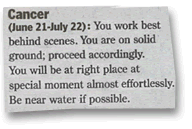13 Aug It’s All in the Background
 Some are headline type of people but I’m mostly a peripheral sort of guy. The edges and the background are where I like to live. If you know me, you might be surprised to hear me say that. I can be pretty forthright and direct. But it’s the underneath and in between I really love.
Some are headline type of people but I’m mostly a peripheral sort of guy. The edges and the background are where I like to live. If you know me, you might be surprised to hear me say that. I can be pretty forthright and direct. But it’s the underneath and in between I really love.
Take music. One of my secret desires is to be a backup singer. My voice is not lead material. And I hold no illusions about its quality. American Idol is neither my desire nor quest (I’m a much better critic of my range and choice of songs than judge Simon Cowell anyway). But singing backup, now that’s something I would love to do.
R and B would be my first choice. A little Aretha, with me standing stage right, in the middle of two really good backup singers. Our hand movements would be refined and independently in unison. Our voices soft but adding to the fullness of the song.
There is subtly to the background. It’s where interesting things often occur. The best is just inside our peripheral vision. If we listen for it or look directly at it we may not even see it. This makes it an even more intriguing place to explore.
I’ve just discovered one of the premiere background artists of the 20th century, Raymond Scott. Scott composed jazz and early electronic music in the 1930s. Born, Harry Warnow, like the great backgrounder he was to become, he took his new name from the phone book. He never meant for his compositions to recede but after Carl Stalling at Warner Bros. began using them as tracks on cartoons Scott’s place in Background History was assured. Those of you who grew up with these mid century toons will be recognize his work. Listen to The Toy Trumpet (Real Audio via Amazon.com) and tell me what zaniness comes to mind. Background coming to the foreground: that’s how we know we’ve been there.
It’s not surprising I’m a photographer. I’ve always been a voyeur: not a Peeping Tom but someone interested in what goes on around corners. When I was about six I was watching my dog through a crack in the door. I remember thinking “I wonder if he’d be doing the same thing if I wasn’t watching him.” I was very existential for my age.
Correct photographic composition dictates that in The Rule of Thirds, the important part of a composition takes place, not in the center of our view, but at the intersections of a three part grid. I like to go a little further. Sometimes the most interesting part of the image is at the very edge and sometimes it’s actually taking place outside of the frame. It’s eluded to by the position, pose, or actions of elements within the picture.
In everyday life, I look to these recesses for a lot of my information. In meetings, what’s she really saying? Oh, I hear what she’s saying but what does she really mean?
This isn’t to say I’m always walking this edge, looking for hidden meanings and agendas. I’m not paranoid. But language can be so subtle and our own filters so overbearing, sometimes we’re missing something important and special if we don’t look and listen carefully. It’s getting harder to find these edges in the news or listening to our politicians. We know about spin. But how can we find out what’s beyond it? Especially when it’s clear we’re not wanted there.
Often there are competing and overlapping issues and it’s often difficult to separate the black from the white. In our neighborhood, the local rescue squad wants to relocate. Its present building, in the center of the business district, is too small.
Simultaneously, the Catholic high school, a mile or so down the street (and close to our neighborhood), is moving. A developer has already petitioned the county to rezone the school’s 15 acres for development. Right now it zoned for one house per half acre. The developer wants to change that so that they can build 15 townhouses on an acre.
Years ago the rescue squad bought three parcels of land next to the high school. They’ve been waiting to develop it and move there. But a county planner suggested a land swap. What if the rescue squad gave their land to the developer (for even more houses I suppose) and in exchange the county would let them relocate to the site of our present community center (which is even closer to our neighborhood—right next to it in fact)? We are concerned about the center’s loss and moving a loud set of fast moving trucks and ambulances next to a residential area and the regional public library.
What do we protest first? Massive urban growth with over 200 new townhouses in a neighborhood of single homes? The increased pressure new children entering the already overcrowded elementary school will add to our children’s education experience? The loss of our community center? Questionable land swaps?
We support our rescue squad. More than 75% of its income comes from neighbors like us. We don’t want them to think we aren’t appreciative of their work, but we don’t want them to move out of the business district and into our quiet neighborhood.
What’s really going on? What’s happening along the edges, whispers after meetings amongst politicians and developers (a little paranoia might be justified here)? Vocal reassurances of support for the Squad mixed with murmers of strange bedfellows. Who is sleeping with whom in this rather murky place is next to impossible to observe. Sometimes the background is a pretty crowded and ambiguous place to be.
In the film, Koyaanisqatsi, Godfrey Reggio shows us what happens when we don’t pay attention to those edges. He states:
“If one lives in this world, the globalized world of high technology, all one can see is one layer of commodity piled upon another. In our world the “original” is the proliferation of the standardized. Copies are copies of copies. There seems to be no ability to see beyond, to see that we have encased ourselves in an artificial environment that has remarkably replaced the original, nature itself.”
Despite my pursuit along the edges, I often suddenly realize how myopic my senses have become. Daily work and family schedules, Palm calendar filled with meetings, playdates, and reports due. Even my recreation is on a path, the bike path this morning. The same beautiful path I ride every weekend. I go around a corner, not too fast, but the wet pavement from the storm the night before makes me slip. More like a glide I remember in slow motion. And suddenly I am scraping along the asphalt, my arm bleeding and my bike chain broken.
I take an immediate inventory, a little in shock. My first thought is, thankfully, no one was watching my spastic ballet. After seeing my arm I wish someone had been there. Otherwise, I am fine and begin walking home. But it’s far and I think I should wash my wound as soon as I can.
I start asking people along the path if they have a phone (nuts, I used to carry mine). And while I’m talking to these people, I realize I’m talking to these people. Formerly on my seemingly unimportant periphery, they are now central to my moment. I walk past a spur in the path that leads to a neighborhood of houses. I’ve never taken this path before but perhaps I can stop and use someone’s phone.
I see two men standing in their open garage. I almost stop, then instinctively move on. At the next house a man is washing his car, a Range Rover. I ask if I can use his phone. Showing my bloody arm is my guest pass into his life. He brings me into his workroom, lifts the phone, and hands me the receiver. It’s a pink princess phone, once in a bedroom and now relegated to the workshop. How incongruous I thought. Funny how in these times your mind is so observant.
When I ask for directions so my wife can pick me up he says “why don’t I take you home.” While I’m familiar with the bike path, once off of it, even so close, I have no idea where I am. I accept with a mixture of relief and gratitude but feel funny. Now my journey off the edge has taken this man in an unforeseen direction.
Once he gets to the main street I see where I am. As we ride up the highway he suddenly says “where’d you get your Kawasaki’s?” Surprised at the non-sequitur, I hear myself thinking “I was riding a bike, not a motorcycle.” I grapple with the connection. Where is my mind? “My eyeglasses, you mean my glasses?” Both he and his wife are optometrists. We talk about drilling holes in these frameless lenses and how the magnetic clip-on sunglasses are so cool to put on (everyone thinks the case is a cell phone and when you whip it out to put on your glasses someone asks if you need to make a call). We reach my house.
I thank him and offer some money for his time and trouble. This isn’t what I want to give him. My gratitude is more important to me. He agrees. And as I walk my bike to the garage I walk away from this edge with a reminder that there’s something special to be found when you live in the background.




Sorry, the comment form is closed at this time.